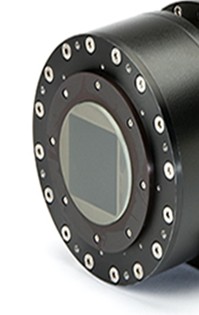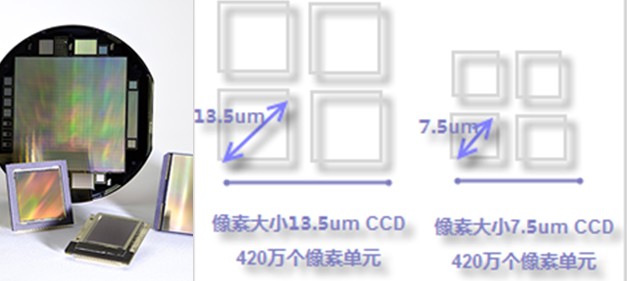CCD introduction
CCD, English full name: Charge-coupled Device, Chinese name: charge coupled components. A CCD is a semiconductor device that converts optical images into digital signals. The tiny photosensitive material implanted on the CCD is called a pixel (Pixel). The larger the number of pixels contained in a CCD, the larger the area of ​​each pixel unit, and the higher the resolution of the picture provided. The CCD acts like a film, but it converts image pixels into digital signals.

The CCD was invented in 1969 by Willard S. Boyle and George E. Smith of Bell Labs. Scientists won the 2009 Nobel Prize in Physics for Boyle and George-E-Smith for "inventing the imaging semiconductor circuit - charge coupled device image sensor CCD".
Measure key indicators of CCD performance
There are many indicators for measuring CCD performance, among which CCD chip size, sensitivity, signal-to-noise ratio, dynamic range, and cooling temperature are important parameters.
1. Pixel: This is a common parameter. In the case where the size of the CCD pixel unit chip is determined, the higher the pixel, the higher the resolution, and the lower the sensitivity, the inverse relationship between the two, so the pixel is not as high as possible, and should be as high as possible when the pixel is sufficient. Priority is given to ensuring sensitivity.
2. CCD chip size: CCD each pixel unit chip size is larger, its sensitivity is higher, because of the inverse relationship between pixel and sensitivity, so the larger the chip size, the better;
3. Dynamic range: In fact, this parameter depends on the other two parameters. Dynamic range = 20Xlog10 (full well electron / total noise) The larger the value of this parameter, the higher the sensitivity of the CCD.
4. Refrigeration temperature: When the temperature of the CCD is increased, noise will be generated, especially for long-time exposure. Lowering the temperature can reduce such noise, so it is necessary to cool the CCD. There are many cooling methods, such as semiconductor refrigeration, water circulation refrigeration, air refrigeration, etc. Therefore, the lower the refrigeration temperature, the higher the signal-to-noise ratio (SN) and the better the imaging sensitivity.
5. Gray scale: usually expressed by bits, such as 14bit (16384) / 16bit (65536), etc. For grayscale analysis or fluorescence quantitative analysis, the higher the CCD gray scale, the better.
From the above aspects, for the key components of today's more popular animal living imaging equipment CCD, all major manufacturers have tried their best to improve CCD performance, such as: Carestream uses 7.4um size of 4.2 million pixels minus 29 degrees absolute Refrigeration CCD; Caliper also uses a 4.2-megapixel cooled CCD to improve image quality; SII multi-mode live imaging system uses Spectral Instruments Imaging's most advanced 4.2-megapixel large-size CCD technology (chip size 13.5um or 22.5um), minus 90 Absolute cooling, dynamic range can reach 6-7, providing ultra-high sensitivity multi-mode imaging protection for bioluminescence, fluorescence, and X-ray imaging.
About Spectral Instruments Imaging (SII) Large Format Scientific Research CCD Introduction
Spectral Instruments is a world-renowned large-format CCD manufacturer. Its CCD production has a long-standing reputation in the fields of cosmic astronomical observation, military measurement, plasma physics and drug screening. The SII multi-mode live imaging system uses its 4.2-megapixel, 90°C absolute-cooled large-format scientific CCD, which greatly improves imaging sensitivity and resolution, and improves signal-to-noise ratio.
Zero 90 ° C absolute cooling large format CCD as shown in the example

Single 13.5um pixel unit CCD photosensitive area = 13.52 / 2 = 91.125um2
Single 7.5um pixel unit CCD photosensitive area = 7.52/2 = 28.125um2
Therefore, the light-sensing area of ​​a 13.5um CCD unit is 3.24 times that of 7.5um. Therefore, in the case of 4.2 million, the 13.5um large-format CCD can be equivalent to the ordinary CCD sensitivity of 13.6 million pixels, which improves the imaging sensitivity and resolution.
Relationship between CCD pixel size and imaging area
Advantages of large size chip CCD
The photosensitive element of the CCD is a pixel, and each pixel is like a well that can be used to store charge. The limit of the charge that can be accommodated in this well indicates the dynamic range of the CCD, that is, the exposure latitude. The size of the CCD directly determines the size of the well. With the same size CCD, when the volume of the pixel is increased, of course, this will cause the number of pixels of the CCD to be relatively reduced, and the ability to accommodate the charge is stronger.
In terms of image noise, excessive image noise is an important cause of detection errors in detection. Too low sensitivity, you need to adjust the larger gain value and longer exposure time when acquiring the same image signal, which is the culprit of noise increase. With a large-size CCD, a single pixel unit can obtain more photons, which improves the imaging sensitivity, so that the exposure time and the gain value are not excessively large to ensure the imaging effect. This is why in the field of weak luminescence such as fluorescence, near-infrared light, chemiluminescence, and bioluminescence, the reason for the large-size CCD chip is more concerned.
Fladrafinil CRL-40 941 Bisfluroadrafinil
CRL-40,941 is a molecule similar to adrafinil, and has been shown to be more effective than these two molecules in their indications, with fewer side effects.
Significant positive effects of CRL-40, 941 include improved memory, greater mental clarity, increased ambition, and overall higher levels of mental performance. As it improves focus, it could be used to treat conditions such as ADHD, Alzheimer's and depression. It also has great use in the treatment of sleep disorders, such as insomnia or narcolepsy.
Application Functions:
1. Improve memory
2. Increased learning ability
3. Improve cognitive processing
4. Improve your responsiveness
5. Improve your perception
6. Reduce anxiety
Reduce depression
What is the application of CRL-40 941?
* Applied in the pharmaceutical field.
* Used in the field of cosmetics.
Describe :
99% CAS 90212-80-9 Norootropic Fladrafinil CRL 40 941 CRL-40,941
|
Product Name |
Fladrafinil CRL-40 941 |
|
Chemical Abstracts Society No. |
90212-80-9 |
|
Appearance |
White powder |
Product photo :

Our company offers variety of products which can meet your multifarious demands.including API Powder.Pharmaceutical Intermediates.Vitamins Powder.Plant Extracts.Food Additive.Peptide Powder and so on We adhere to the management principles of "quality first, customer first and credit-based" since the establishment of the company and always do our best to satisfy potential needs of our customers. Our company is sincerely willing to cooperate with enterprises from all over the world in order to realize a win-win situation since the trend of economic globalization has developed with anirresistible force.
Crl-940.-,941,Fladrafinil Crl-40 941,Mt2 Nasal Spray,Stock 99% Noopept Nootropics
Shaanxi YXchuang Biotechnology Co., Ltd , https://www.peptide-nootropics.com